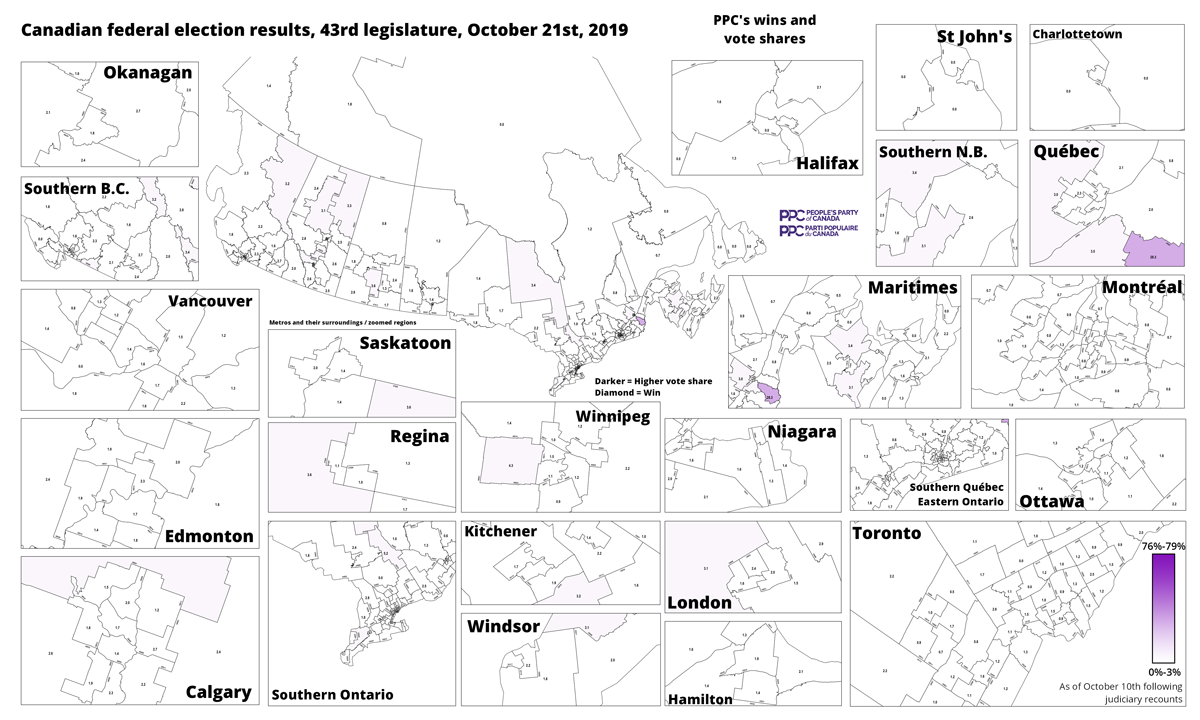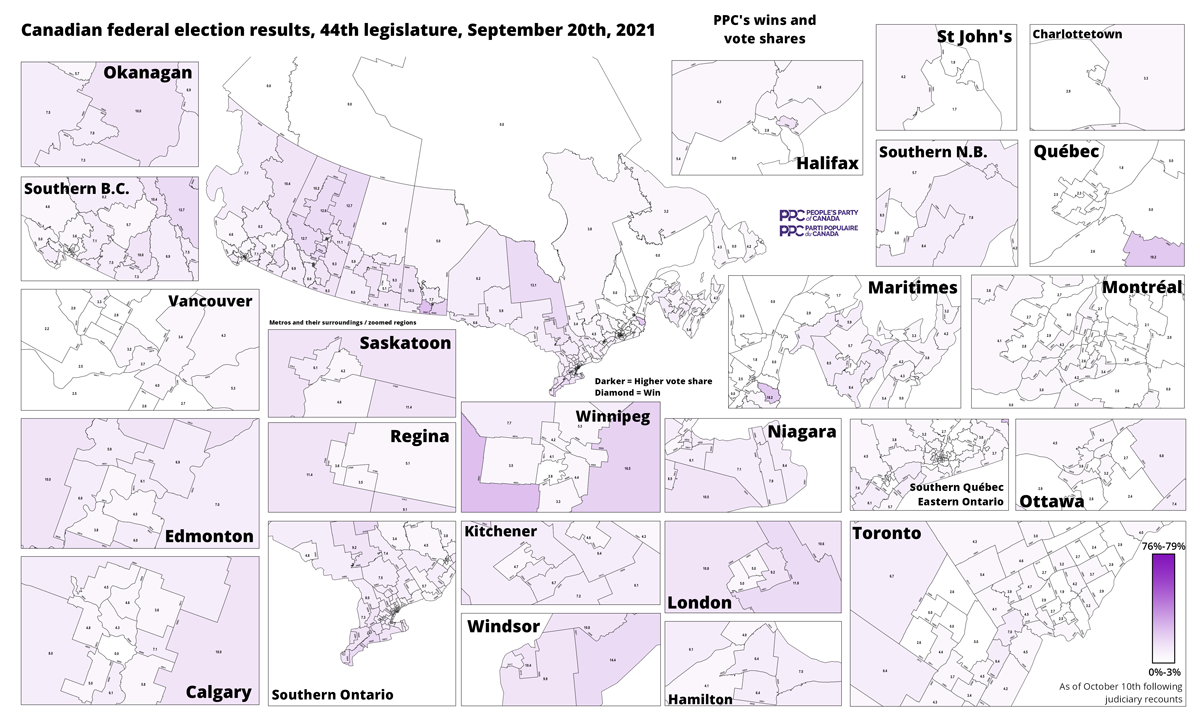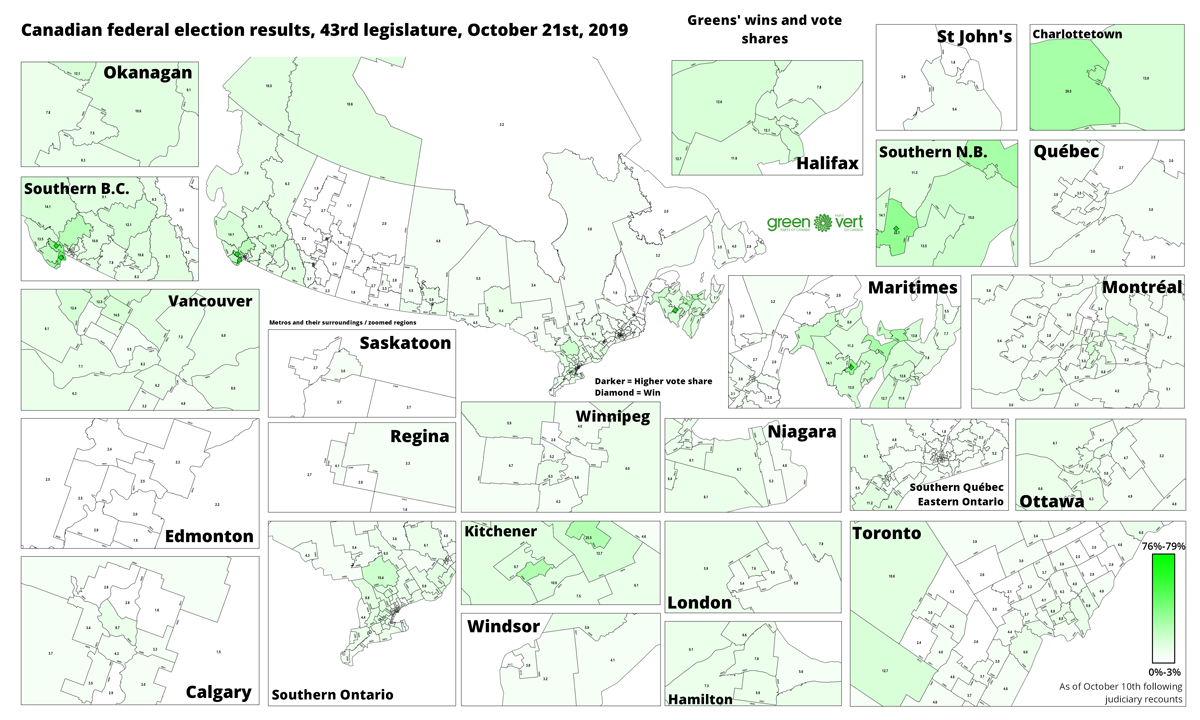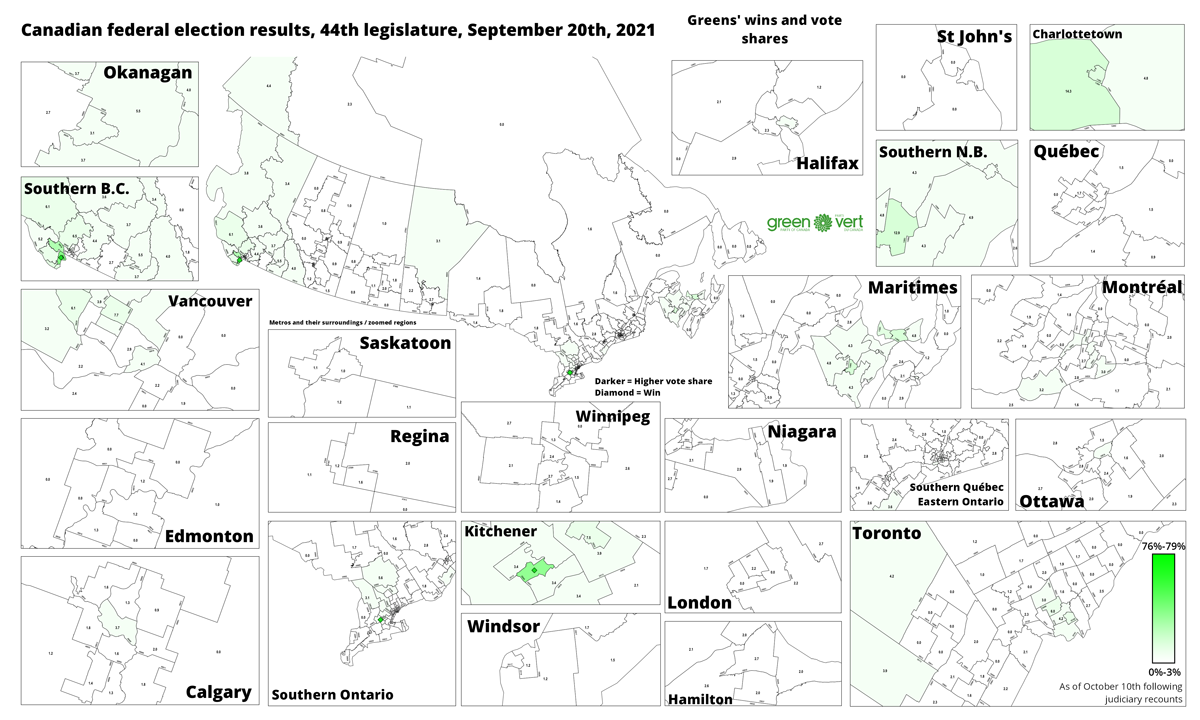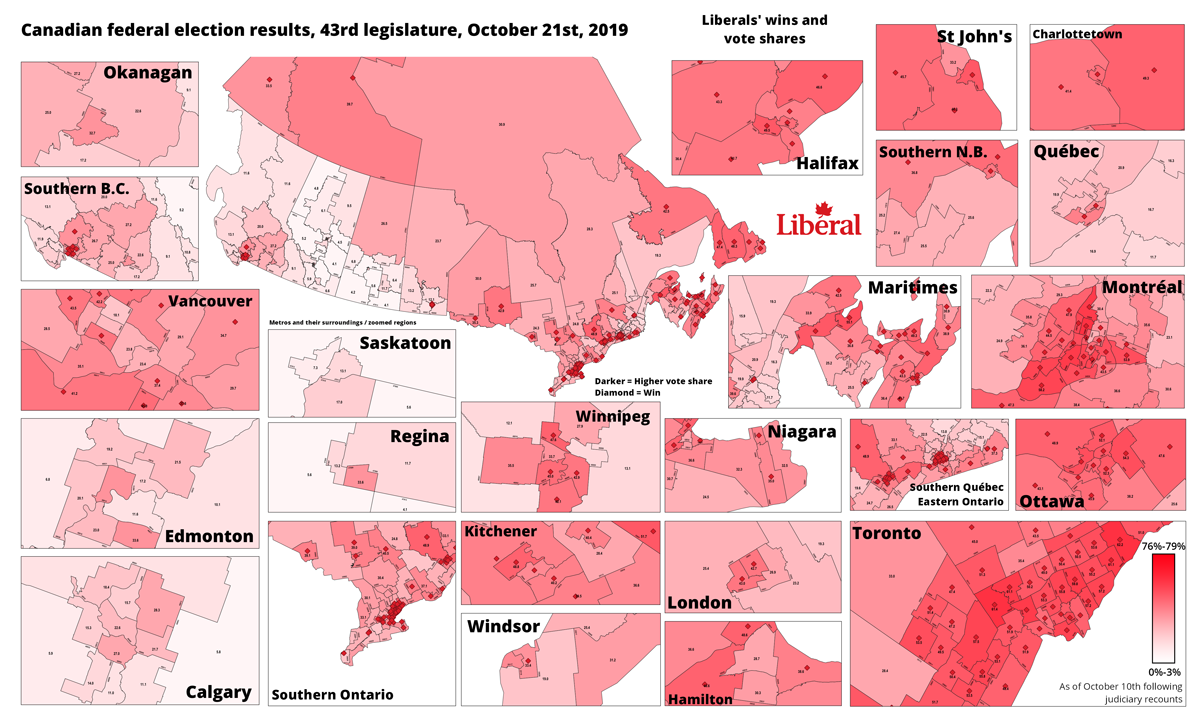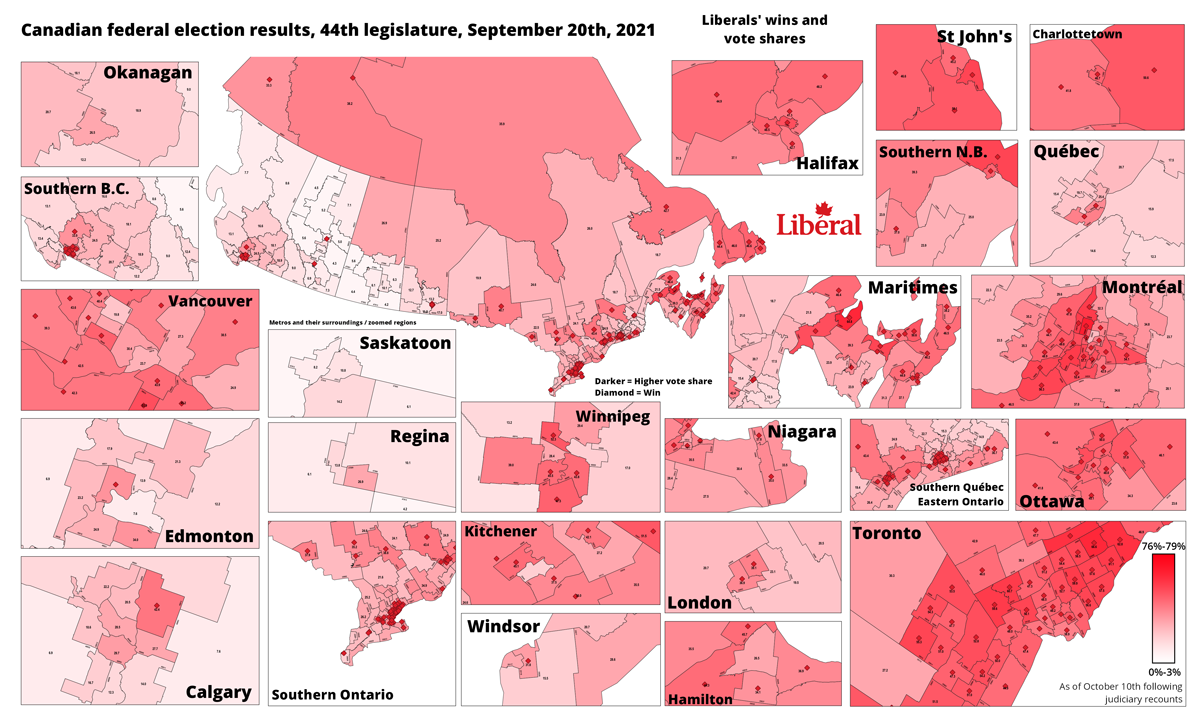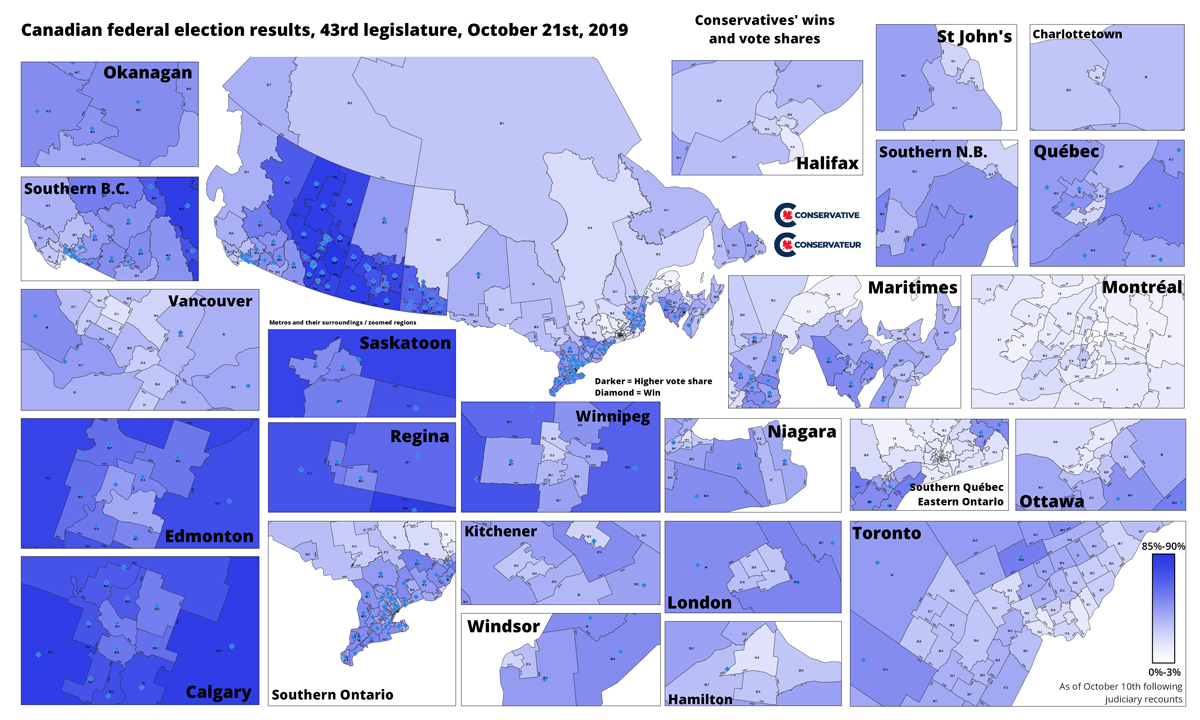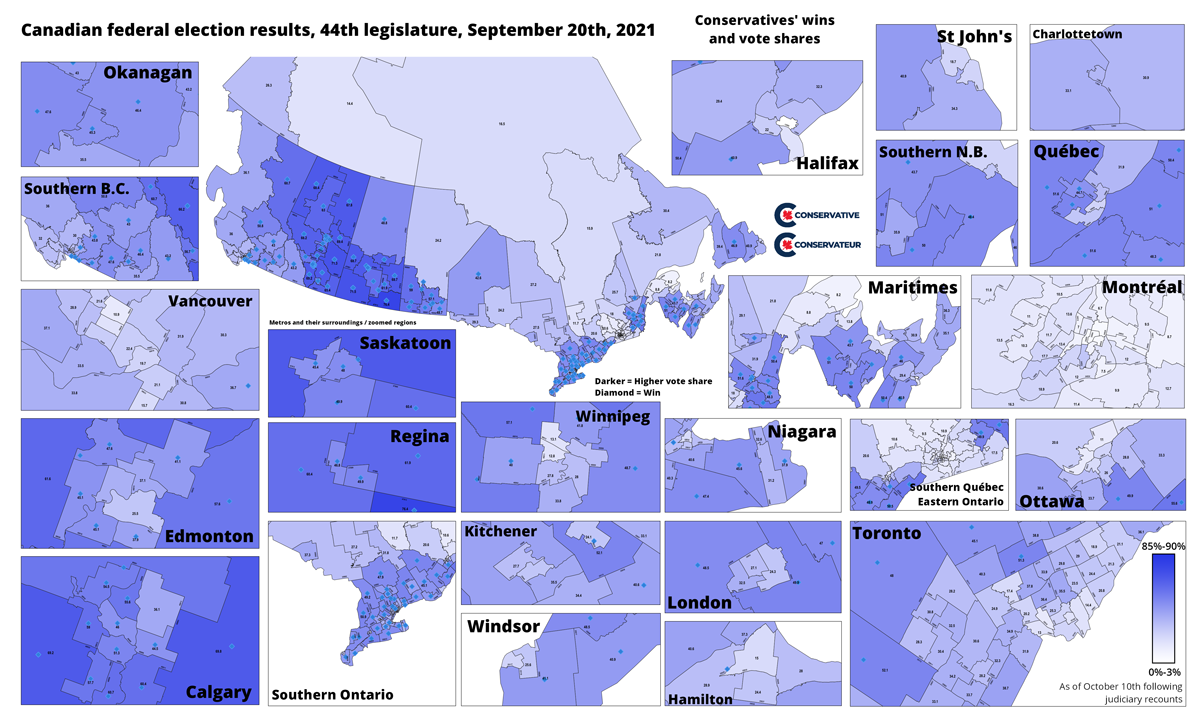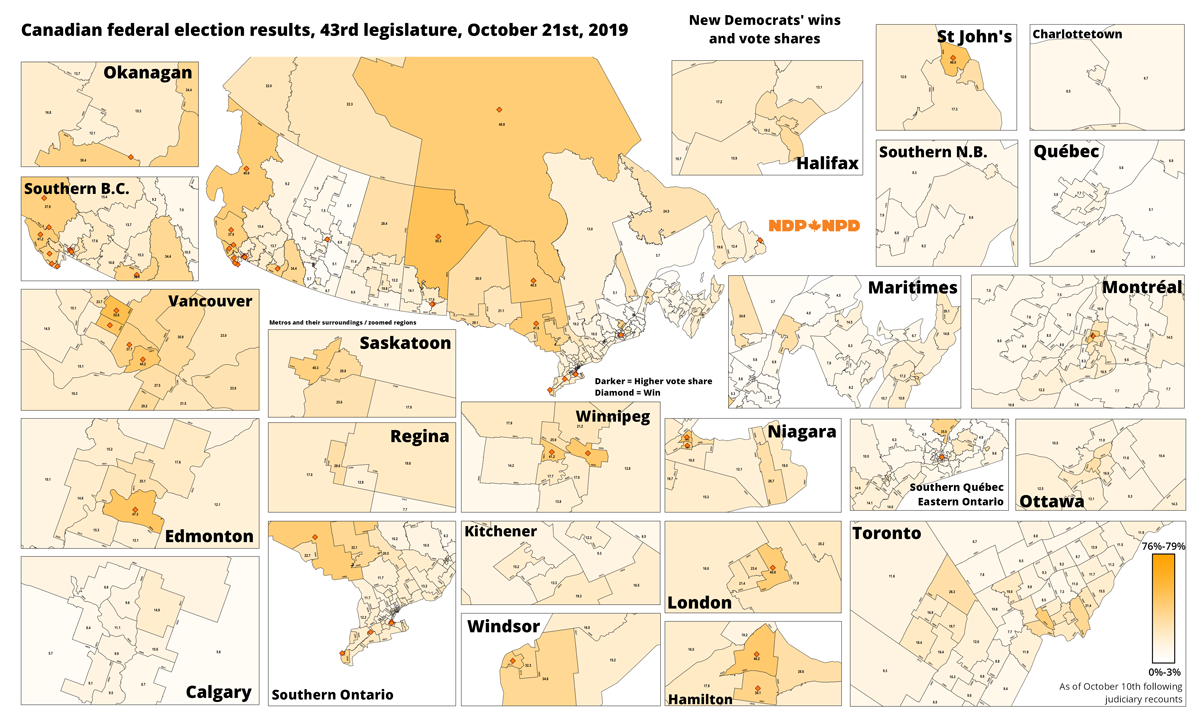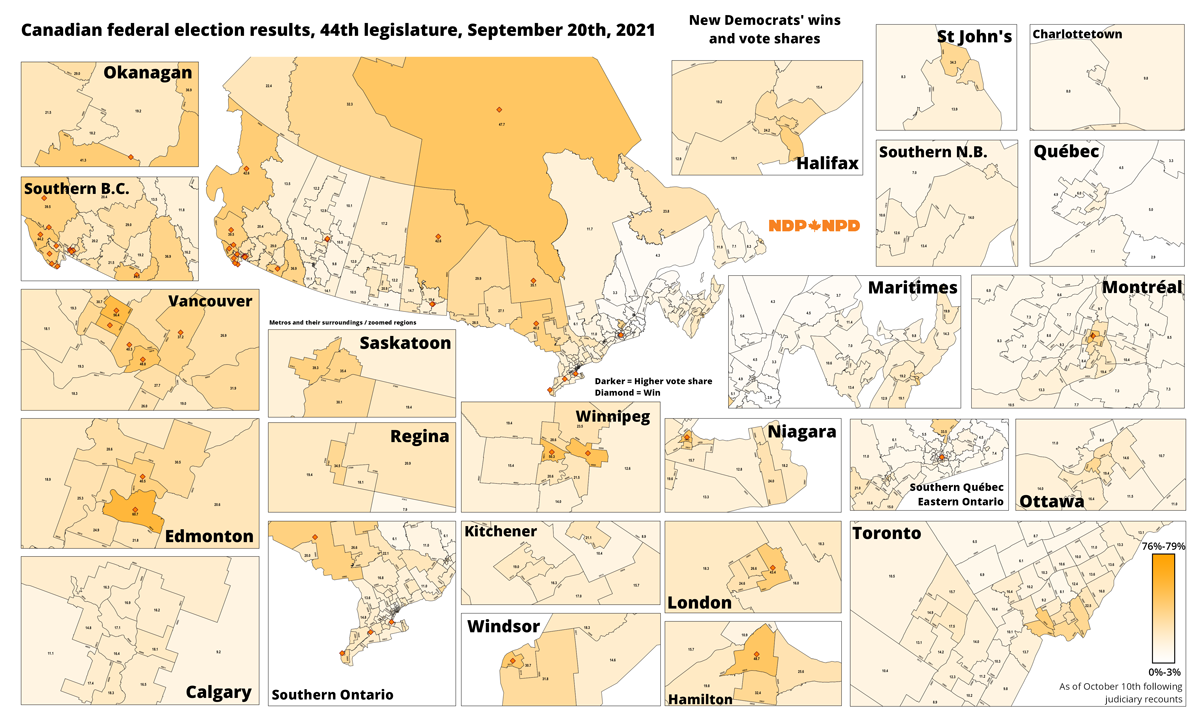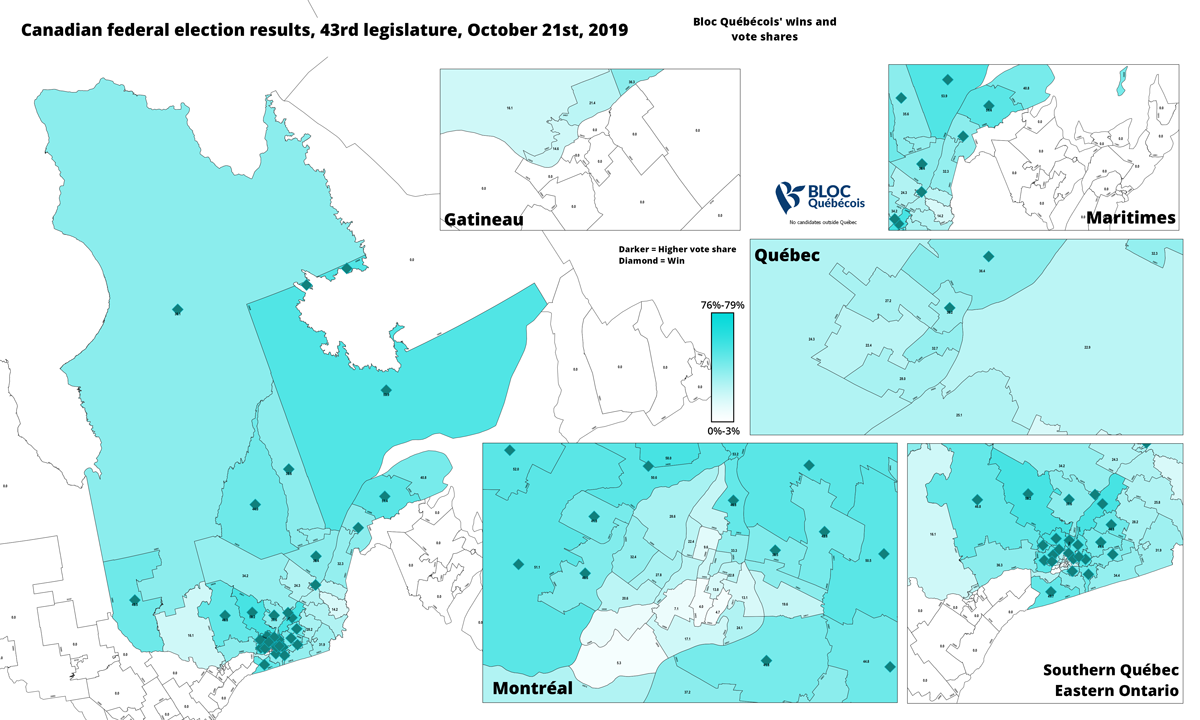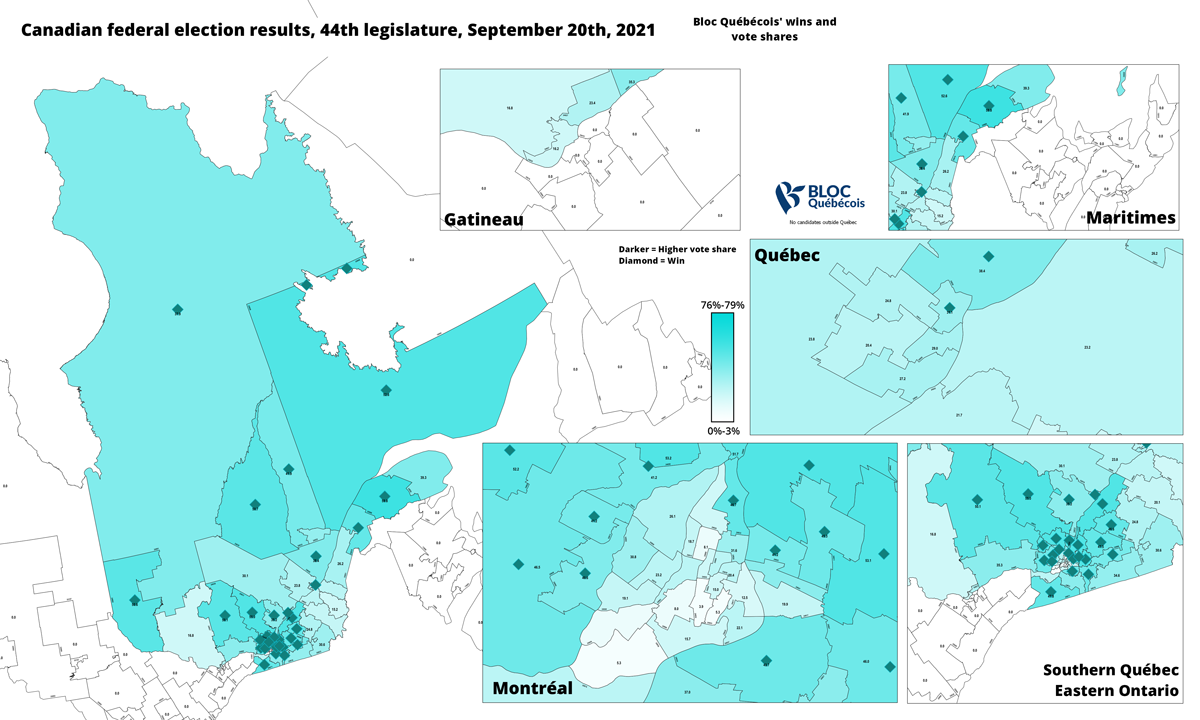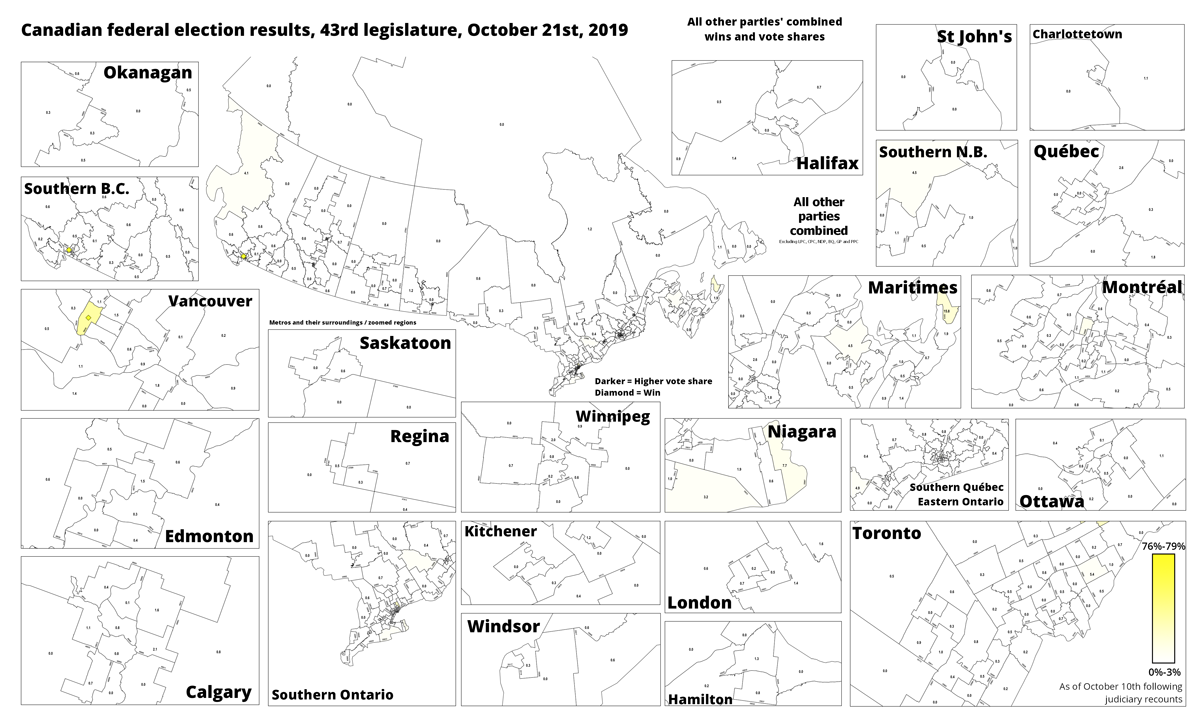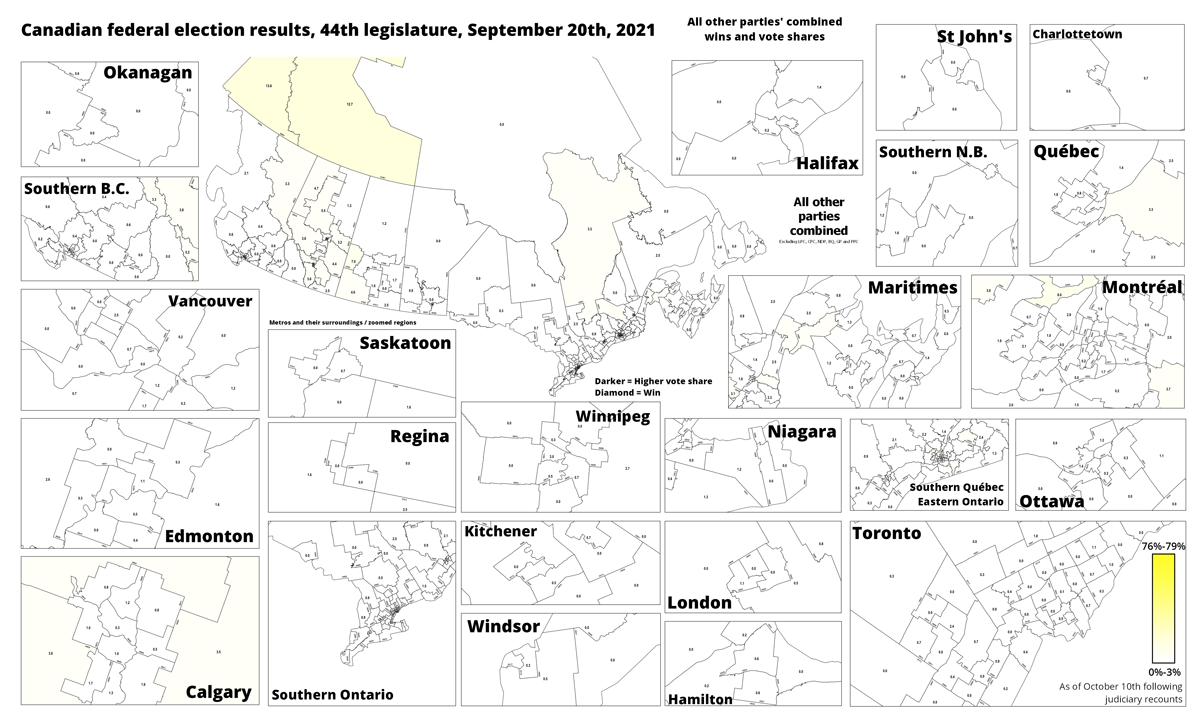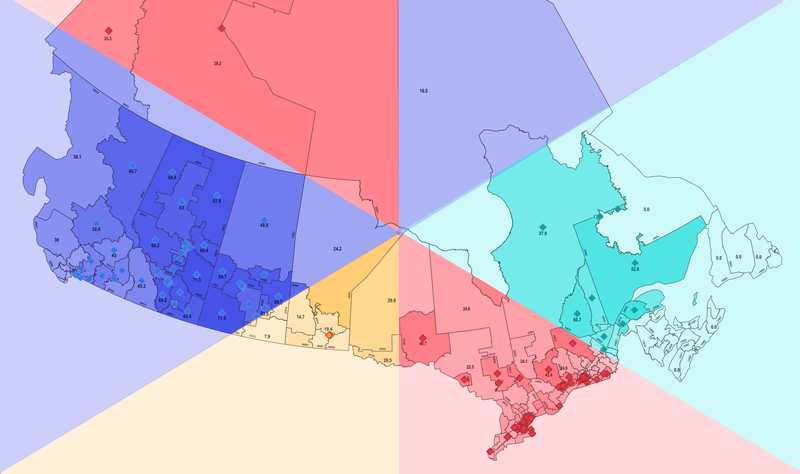
You might think that the latest general federal election was pointless, and looking at the results it feels like that. Even looking further than the winning seats, there is little change compared to 2019.
But there’s been some notable, Canada-wide movement in two of the political parties, the young People’s Party of Canada (PPC), and the much older Green Party of Canada (GPC).
The former is the only one who has noticeably increased his popular support in many ridings. For the Greens, it’s the other way around.
Actually, it’s as if the PPC and the GPC swapped vote shares. Not that the Green voters actually shifted to Maxime Bernier’s party. It’s just that the former’s increased support within ridings happens to be roughly equivalent to the latter’s decreased vote shares.
It’s quite clear when you look at the following maps. For each party, the map show the differences in vote shares within ridings between the 2021 election and the one before in 2019.
The Greens and The People’s Party “swapped” vote shares
People’s Party of Canada, map of vote shares obtained by riding, 2019 vs. 2021
Click and slide to compare both elections
Click to enlarge the 2019 results. Those of 2021.
Green Party of Canada, map of vote shares obtained by riding, 2019 vs. 2021
Click and slide to compare both elections
Click to enlarge the 2019 results. Those of 2021.
In 2019, if we had had a fully proportional electoral system, the Greens would have obtained 22 seats (actual vote share of 6.55 %).
In 2021, they would have won 8 seats (2.33 %).
In 2019, in the same imaginary context, the People’s Party would have won only 5 seats (1.62 %).
In 2021, this figure would have been 17 (4.94 %).
There is still no Maxime Bernier in Ottawa, but the People’s Party fared quite well in the West. And not only there, if we keep in mind this party was created 2 years ago. There’s a lot more purple in Manitoba south of Winnipeg but also about everywhere in Ontario outside the biggest cities.
Now, there are only a couple of ridings where this shade of purple is worth double digits, and it stays below 20 % in most cases, but that is still a significant improvement compared to 2019.
But the picture is more telling when we look at some other numbers. In 2019, the only two-digits vote share the party could get was in the riding where the leader Bernier ran. In this year’s election though, this number jumped to 25.
As for the Greens, they used to have double digits percentages in several places at both ends of the country, even in a few ridings in Ontario, but it’s all gone now.
Including their wins, the Greens got above 10 % of all votes in six ridings nationally. In 2019, that figure was 49.
One can only wonder why the party’s leader decided to put all their efforts and resources into her own race of Toronto Center, where she scored 7.1 % in 2019 and 8.6 % in 2021. Looking at the 2019 results, opportunities were clearly in British Columbia and the Maritimes.
The Big Four parties: when emptiness is mind-blowing
I may as well do the same exercise with the four main parties. Differences are so negligible, it’s mesmerizing. I made a point of making sure I am not just showing you the same map twice, but the data won’t budge any more than that.
To be fair, there has been some color change in a couple of ridings, but only to be countered by opposing changes elsewhere in most cases.
And yes, the Conservatives did lose some support (and seats) in Alberta. But more often than not, they went from winning Soviet-style majorities to almost Soviet-style majorities. Those are still very cozy.
You can slide the maps horizontally to see the (very modest) differences between the 2019 results and the 2021 ones. The darker the riding colors, the higher the vote share for the party.
Note that these maps were made to be zoomed in, which allows you to explore the data more deeply and see the percentages of votes within the ridings (click on the links below each map to have a look at them individually).
Liberals: just get back to work already
Liberal Party of Canada, map of vote shares obtained by riding, 2019 vs. 2021
Click and slide to compare both elections
Click to enlarge the 2019 results. Those of 2021.
As columnist Chantal Hébert said, it is clear that the main message from the voters in 2021 was: “just get back to work already”. The maps above show little significant change. A higher vote share (darker) in one riding usually was compensated by a lower share somewhere else.
Let’s just go to the next party.
Conservatives: we’ve recentered ourselves yet we practically got the same outcome
Conservative Party of Canada, map of vote shares obtained by riding, 2019 vs. 2021
Click and slide to compare both elections
Click to enlarge the 2019 results. Those of 2021.
The Conservatives didn’t lose much in terms of seats and their national vote share. But the Western parts of the country are somewhat less blue than in 2019. They still won what they usually win, thanks to their larger-than-life majorities.
As we will see below, those lost votes seemed to benefit the NDP. But the now-stronger-than-ever People’s Party also attracted more votes this election. Obviously, those hypothetical voters that went PPC or NDP after voting Conservative in 2019 probably didn’t hesitate between the two formers, but rather between the Conservatives and the PPC, and the Conservatives and the NDP (the Liberals still seem to be a cursed brand in the province outside the two biggest cities).
The Tories did win more votes in the East though, which seems to compensate for their losses in the West. They obtained somewhat higher vote shares in the Maritimes and some parts of Eastern Québec.
New Democrats: a slightly more orange West
New Democratic Party of Canada, map of vote shares obtained by riding, 2019 vs. 2021
Click and slide to compare both elections
Click to enlarge the 2019 results. Those of 2021.
There isn’t much to say about the New Democrats’ performance. They improved slightly their vote shares in some parts of Alberta and British Columbia, and that’s pretty much it. Their scores are impressively similar in Québec and Ontario between 2021 and 2019 if we put 4 or 5 ridings aside, out of like 200.
Bloquistes: Y’a pas grand chose dans l’ciel à soir
Bloc Québécois, map of vote shares obtained by riding, 2019 vs. 2021
Click and slide to compare both elections
Click to enlarge the 2019 results. Those of 2021.
One has to look really, really close to observe any change for the Bloc between 2021 and 2019. I double-checked the data several times just to make sure I didn’t map the same data twice or something. There are only a few slight, insignificant changes in some ridings, and you’ll have to go mad with the slider before you can even notice them.
Everyone else: some change up north
All other parties and candidates combined, map of vote shares obtained by riding, 2019 vs. 2021
Click and slide to compare both elections
Click to enlarge the 2019 results. Those of 2021.
In the 2019 election, all of the other parties’ combined votes (including independent candidates) were negligible at best, except for one win in Vancouver which was Judy Wilson-Raybould, the former Liberal minister.
But there are some yellow shades up north following the 44th election, in Yukon and the Northwest Territories. These are the only two ridings where a candidate not running with any of the six biggest parties made it past 10 %. In both cases, the candidates were running as independents.
Now, after all this hassle for little more than some moderate entertainment for political geeks like me, I do believe some of the major leaders when they publicly opined that this legislature can probably last a bit longer than two years this time.
